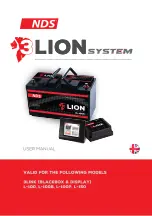
6
USING THE OPTIMATE 6
VERY FLAT NEGLECTED BATTERIES:
If the battery is deeply discharged (and possibly sulfated), remove from the
vehicle or equipment and inspect the battery before connecting the charger for a recovery attempt.
The charger’s TURBO recovery mode cannot engage if it senses that the battery is still connected to a circuit
which
effectively offers a lower electrical resistance than the battery on its own. However, if the deep-discharged battery is not removed
for recovery, neither battery nor vehicle or equipment electronics will be damaged.
Pay particularly close attention to the
following
A battery left deep-discharged for an extended period may develop permanent damage in one or more cells. Such
batteries may heat up excessively during high current charging.
Monitor the battery temperature during the first hour, then hourly there-after. Check for unusual signs, such as bubbling or leaking
electrolyte, heightened activity in one cell compared to others, or hissing sounds. If at any time the battery is uncomfortably hot to
touch or you notice any unusual signs, DISCONNECT THE CHARGER IMMEDIATELY.
CHARGING TIME
Charge time on a flat but otherwise undamaged battery is slightly less than 25% of the battery’s Ah rating, so a 100Ah battery
should take no more than about 25 hours to progress to the self-discharge check (§ 5).
Deep-discharged batteries may take significantly longer.
If using the OptiMate 6 on a severely discharged battery of larger than 240Ah capacity, a full charge may not be achieved within the
72 hour charge safety limit. In this case follow the reset procedure below.
RESETTING THE CHARGE & TEST CYCLE
Disconnect from the AC mains. Wait for the POWER ON LED #1 to go out. Upon reconnection to AC power LEDs #6, 7 and 8 will flash
twice to confirm micro processor health, irrespective if the charger remains connected to a battery or not.
ECO POWER SAVING MODE WHEN THE CHARGER IS CONNECTED TO AC SUPPLY:
The power converter switches to ECO mode when the charger is not connected to a battery resulting in a very low power draw of
less than 1.7W, equivalent to power consumption of 0.042 kWh per day. When a battery is connected to the charger power
consumption depends on the current demand of the battery and its connected vehicle / electronic circuitry. After the battery has
been charged and the charger is in long term maintenance charge mode (to keep the battery at 100% charge) the total power
consumption is estimated to be 0.060 kWh or less per day.
PROCEEDING TO CHARGE
The LED indicators below are sequenced as they may come on through the course of the program.
2
1
AC:100-240V
REVERSE
POLARITY
7
6
6
5
5
TEST MAINTAIN
AMPS
5A max.
1A - 4A
ampmatic
0.2 - 1A
10
9
OPTIMIZE
CHARGE
SAVE
LED MODE
- - - -
4
4
3
3
TURBO
SAVE
8
POWER ON: LED #1
-
Confirms AC power supply to the charger.
HIGH and LOW intensity indication: The"POWER ON" LED #1 will indicate brightly when current is delivered to the battery.
The "POWER ON" LED #1 will reduce intensity to a low level to indicate low power "ECO" mode. This will occur if there is no battery
connected, or when a battery is connected and the program finds itself in the voltage retention test mode or the 'rest' periods of
Maintenance Charge mode.
REVERSE POLARITY PROTECTION: LED #2 -
Lights when the battery connections are incorrect. The charger is electronically
protected so no damage will result, and the output will remain disabled until the connections are corrected.
CHARGE CURRENT BAR: LED #8, 9, 10 -
Lights when pulsed or continuous current is delivered to the battery.
Current level indications:
LED #8:
0.4A minimum current.
LED#8 and 9:
0.4A - 4.5A The
ampmatic
™ charge current program automatically determines the most efficient rate of charge
current for the connected battery.
LED #8, 9 and 10:
5A maximum current.







































